
* Although the Lightning's primary roles were as a fighter-bomber and reconnaissance platform, there were a number of conversions to other configurations, including a range of experimental fits. There was also effort to build two follow-ons, resulting in the "XP-49" and the "XP-58". This chapter describes these machines, and also discusses the P-38's postwar career.
* While the Lightning didn't do so well in the air-to-air combat role in Northern Europe, it was regarded as an excellent strafer and light fast bomber aircraft. To capitalize on this capability, a number of P-38Js and P-38Ls were field-modified in the UK as formation bombing "pathfinders", fitted with a glazed nose with a Norden bombsight, with the machine guns and cannon deleted and a hatch under the nose for the bombardier. They were called "Droop Snoot" machines. A Droop Snoot pathfinder would lead a formation of other P-38s, each overloaded with two 900-kilogram (2,000-pound) bombs, and the entire formation would release when the pathfinder did. The rest would then go down low to strafe the target.
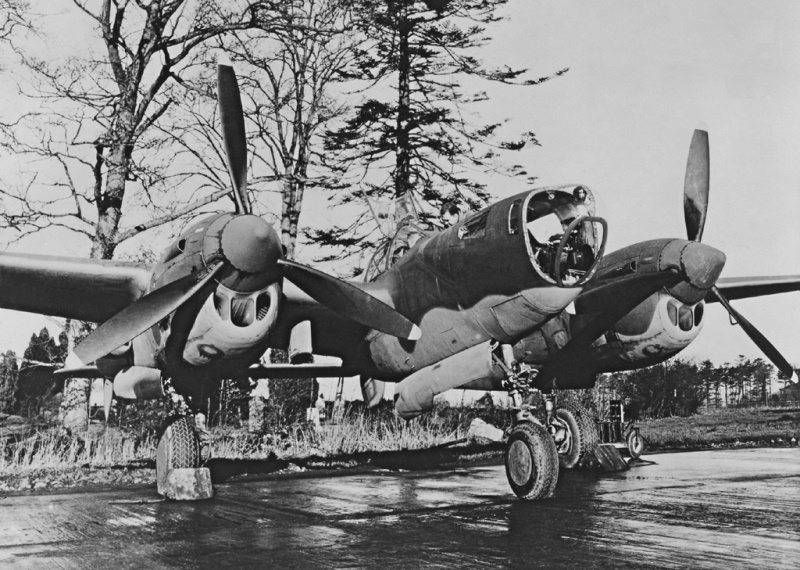
The initial pathfinder raid was performed on 20 April 1944 against a Luftwaffe airfield in France. Results of pathfinder raids were good, but optical bombsight bombing was only possible in clear weather, which was not always the norm for Northern Europe. As a result, a number of pathfinders were built with an H2X radar "bombing through overcast" nose. The H2X, also known for some reason as "Mickey", was a crude targeting radar by modern standards, only able to pick out targets marked by lakes or confluences of rivers, but it was better than nothing. Apparently it was short for "Mickey Mouse", because it was unreliable, or because some of the installations on the different types of aircraft that carried it were awkward.
* A number of Lightnings were modified as night fighters. There were several field or experimental modifications with different equipment fits that finally led to the "P-38M Night Lightning" night fighter. 75 (some sources give 80) P-38Ls were to be modified to the Night Lightning configuration, painted dead-black with flash cones on the guns, an AN/APS-6 radar pod below the nose, and a second cockpit with a raised canopy behind the pilot's canopy for the radar operator. The headroom in the back cockpit was limited, and radar operators were preferably of short stature.
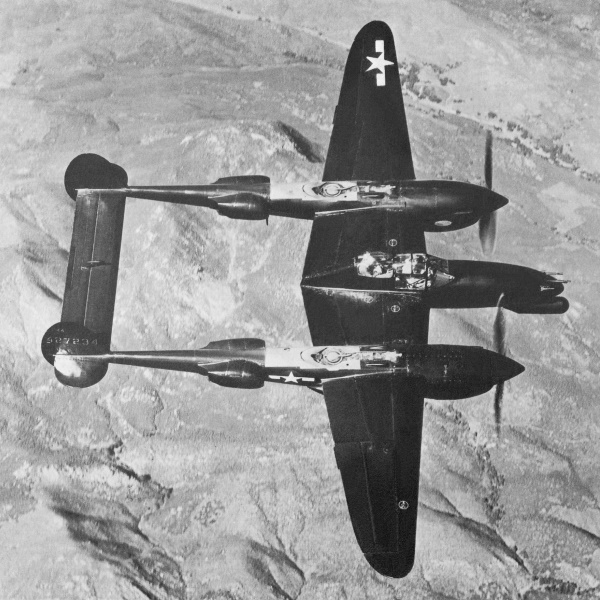
The additional external clutter imposed surprisingly little penalty on the P-38M's performance, and in fact it was faster than the purpose-built Northrop P-61 Black Widow night fighter. Four Night Lightnings saw some combat duty in the Pacific towards the end of the war, but with the end of the war they were no longer needed, and that was the end of the program. It is unclear how many P-38M conversions were actually performed, but all the machines slated for the program were scrapped.
BACK_TO_TOP* Lockheed also built two sister designs to the P-38: the "XP-49" and the "XP-58 Chain Lightning".
In the spring of 1939, the Air Corps issued a request for an advanced twin-engine long-range escort fighter, to be derived from an existing type and fitted with advanced high-performance engines. Lockheed responded to the request with the "Model 222", which was much like a P-38 except that it had a pressurized cabin and was to be powered by 24-cylinder inline Pratt & Whitney X-1800-SA2-G engines, then in development and expected to provide over 1,490 kW (2,000 HP). The Model 222 was to be armed with four 12.7-millimeter and two 20-millimeter guns.
The Model 222 won the competition, with the Air Corps ordering a single prototype as the "XP-49" in October 1939. Lockheed proposed that production P-49s be fitted with turbocharged Wright R-2160 Tornado radials with 1,715 kW (2,300 HP) each, which would give the P-49 an estimated performance of 800 KPH (500 MPH) at altitude.
Work on the XP-49 went slowly, since Lockheed was caught up in the prewar US military buildup. As development work plodded along, both the Air Corps and Lockheed began to have doubts, for various reasons, about the powerful engines to be fitted to the aircraft, and so the design was changed to incorporate two Continental XIV-1430-9/11 12-cylinder inverted-vee engines with 1,150 kW (1,540 HP) each for take-off. Engine availability further delayed development of the aircraft, and the XP-49 didn't take to the air until April 1942.
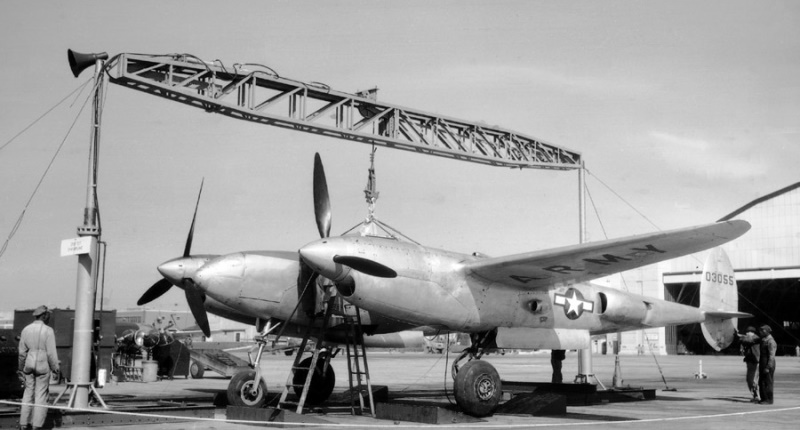
The XP-49 looked much like a P-38, except for greater length and longer nacelles, and in fact the two aircraft shared about two-thirds of their parts. The aircraft was evaluated into the summer of 1943, but the Continental engines were troublesome.
___________________________________________________________________
LOCKHEED XP-49:
___________________________________________________________________
wingspan:
15.85 meters (52 feet)
wing area:
30.42 sq_meters (327.5 sq_feet)
length:
12.22 meters (40 feet 1 inch)
height:
2.99 meters (9 feet 10 inches)
empty weight:
7,020 kilograms (15,475 pounds)
max take-off weight:
8,505 kilograms (18,750 pounds)
maximum speed:
737 KPH (458 MPH / 398 KT)
service ceiling:
12,200 meters (40,000 feet)
range:
1,287 kilometers (800 MI / 649 NMI)
___________________________________________________________________
Some sources claim that the XP-49 had few if any performance advantages over existing P-38 production, others cite a test pilot as saying it could "fly rings around the Lightning" -- but whatever the case, the USAAF abandoned all plans to put the XP-49 into production. The single prototype was used for occasional tests, including being dropped from a crane to simulate hard landings, and was finally scrapped in 1946.
* The XP-58 actually started life in the spring of 1940 as an advanced escort fighter version of the P-38, with the development at the request of the USAAF. Single-seat and two-seat versions were considered, the two-seat version to be fitted with additional turret-mounted armament. The single-seat version was quickly abandoned, and the two-seat version went through a number of radical design changes, particularly with regards to engine fit. With the outbreak of the Pacific War in December 1941, the project was more or less put on the "back burner", with most of the staff moved to higher-priority projects. The USAAF then began to flip-flop on requirements, redefining the XP-58 as a ground attack aircraft, then a bomber, then an interceptor, with a bewildering variety of equipment fits considered. The single XP-58 prototype finally flew on 6 June 1944.
The XP-58 was a substantially more radical departure from the original P-38 design than the XP-49. While the XP-58 had the general Lightning configuration, nobody could have mistaken it for a Lightning. It was a monster, more on the scale of the Northrop P-61 Black Widow night fighter, and powered by two 24-cylinder Allison V-3420-11 inline engines with 1,565 kW (2,100 HP) each -- a V-3420 amounting to two V-1710s jammed together.
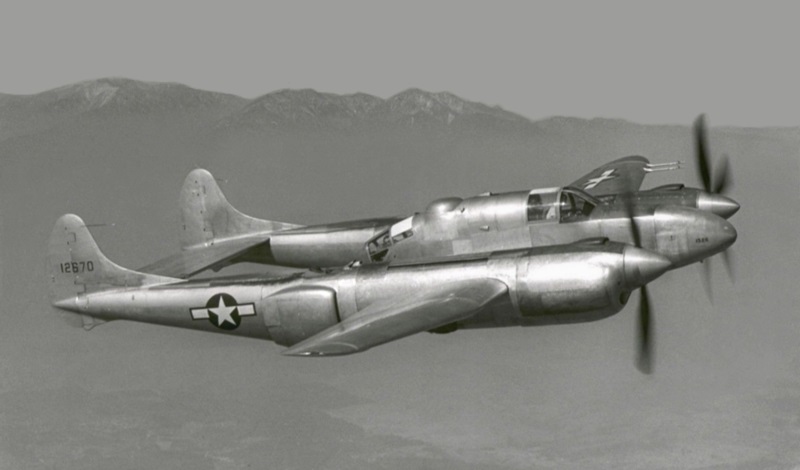
The XP-58 was to mount four 37-millimeter fixed forward-firing cannon in the nose; two remote-control barbettes, each with two 12.7-millimeter machine guns, were to be fitted at the rear of the fuselage. An alternate forward armament of two 12.7-millimeter machine guns and a 75-millimeter cannon, for breaking up bomber formations, was also considered -- but in reality, no armament was ever fitted.
___________________________________________________________________
LOCKHEED XP-58 CHAIN LIGHTNING:
___________________________________________________________________
wingspan:
21.34 meters (70 feet)
wing area:
55.74 sq_meters (600 sq_feet)
length:
15.06 meters (49 feet 5 inches)
height:
3.66 meters (12 feet)
empty weight:
9,070 kilograms (20,000 pounds)
max take-off weight:
17,780 kilograms (39,000 pounds)
maximum speed:
702 KPH (436 MPH / 380 KT)
service ceiling:
12,200 meters (40,000 feet)
range:
4,830 kilometers (3,000 MI / 2,610 NMI)
___________________________________________________________________
By the time the prototype flew, the USAAF had completely lost interest in the project; the flight test program was brief and indifferent. A second prototype was never completed, and the one flying example was scrapped after the war. Whether the XP-58 would have been a good idea or not, it still would have been interesting to see what would have happened if it had actually hit something with four 37-millimeter cannon!
BACK_TO_TOP* There were a number of oddball experimental modifications of the Lightning:
* The P-38's final report card gave somewhat mixed grades. On the negative side, it was certainly harder to fly than the best single-engine fighters, pilots suffered badly from the cold in northern climates, and its twin turbocharged Allisons were particularly temperamental under such climate conditions -- in fact, these last two problems were much of the reason why the Eighth Air Force gave up on the P-38 for high-altitude escort missions. Engine problems were not anywhere near as great in warmer climates, though its liquid-cooled engines were regarded as overly vulnerable to combat damage. Later model P-38Ls featured better heater, defroster, and engine fire extinguisher systems that helped fix the problems.
It did not have a reputation for being maneuverable, though it was surprisingly agile at low altitudes. Its real virtues were long range, heavy payload, high speed, fast climb, and concentrated firepower. Clustering all the armament in the nose meant that Lightning pilots had to be good shots, and Dick Bong would fly recklessly in towards his targets to make sure he hit them, in some cases flying through the debris of his victim. However, the clustered guns also had a "buzz-saw" effect on the receiving end, and made the aircraft useful for strafing as well. The Lightning didn't rank up with the Mustang as an air superiority aircraft, but it got high scores for general versatility.
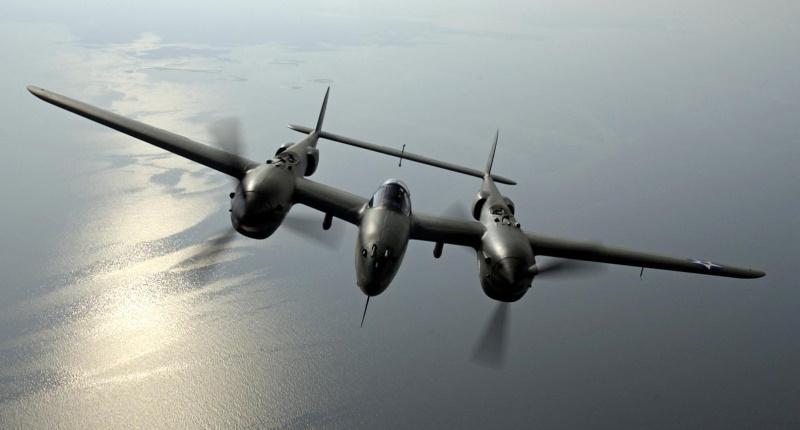
Over 10,000 Lightnings were manufactured in all, and it was one of the few combat aircraft that had been in production at the beginning of the war that was still in production at the end.
* The end of the war left the USAAF with thousands of war-weary P-38s on their hands, rendered obsolete by the jet age. Fifty late-model Lightnings were provided to Italy and operated for several years, with some fitted with an additional cockpit on an extended nose and used as dual-control trainers, designated "P-38DC". A dozen were also sold to Honduras. The others were put up for sale for $1,200 USD apiece to whoever wanted one, and the rest were scrapped.
Lockheed test pilot Tony LeVier was among those who came up with the money to buy a P-38 and run it as an air racer. The Lightning was a popular contender in the air races from 1946 through 1949, with brightly colored Lightnings making screaming turns around the pylons.
P-38s and F-5s were bought by aerial survey companies and used for aerial mapping, with some featuring stretched glass noses. From the 1950s on, however, the Lightning steadily declined, and today only a little more than two dozen exist, with a handful still flying. One particularly pretty example is a P-38L owned by the Lone Star Flight Museum in Galveston, Texas, painted in the colors of Charles MacDonald's "Putt Putt Maru." Another prominent flying example is the Red Bull "White Lightning", which is an interesting hybrid, a P-38L with early-style "art deco" engine intakes.
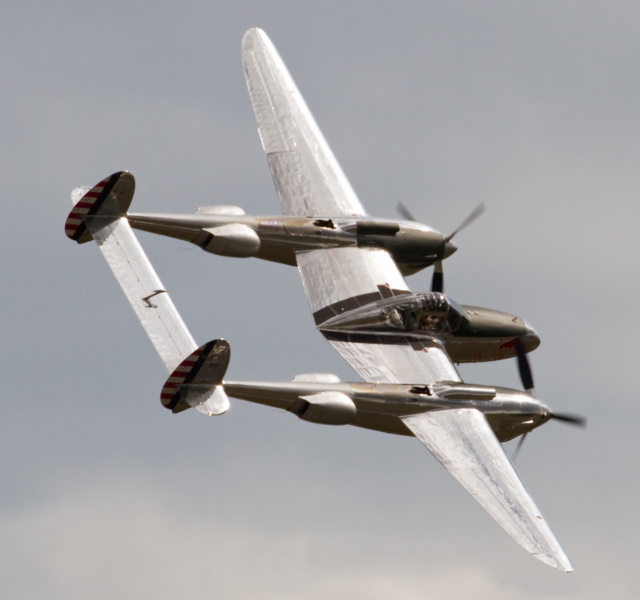
One of the most remarkable flying survivors is a P-38 named "Glacier Girl". On 15 July 1942, six P-38Fs and two B-17Es were flying from Greenland to Iceland on a leg of a trans-Atlantic shuttle to Britain when they ran into a blizzard. They turned back to Greenland but the base was socked in, and they were forced to belly in on the Greenland icecap. One P-38 flipped over on landing, but none of the aircrew received any serious injuries; in fact, the aircraft suffered very little damage. The aircrew were dropped survival gear and rations and were hauled out by dogsled about ten days later. One pilot threw the keys of his P-38 on the fighter's seat for anyone who wanted to recover the thing later.
The eight aircraft of the "Lost Squadron" forgotten until 1981. Two Americans, an airplane dealer named Patrick Epps JR and an architect named Richard Taylor, were chatting. Taylor owned a Learjet, but told Epps he really wanted a P-38. Epps replied that he knew where six were, and said they would be "like new". All they would have to do is shovel some snow off them.
They mounted a number of expeditions to find the machines, finally locating them in 1988 with ice-penetrating radar. Epps knew they would be buried in ice, but everyone was astounded when they found the aircraft at a depth of well over 86 meters (250 feet)! That was more than Epps and Taylor expected, and they were not able to follow up the matter by themselves. Ultimately the project to recover the aircraft passed on to a Kentucky businessman named J. Roy Shoffner.
A series of expeditions used a hot-water drill to bore down through the ice and reach the aircraft. The recovery crew went down to a B-17 first, which turned out to have been crushed by the weight of the ice, but then they went for one of the P-38s, and found it in excellent condition. They melted out a cavern around the P-38, dismantled it, and brought it to the surface in August 1992.
The P-38F was transported back to the US, to be brought back up to operational trim after 50 years in the deep freeze. Although the airframe had suffered some damage under the ice, about 80% of it was still usable. The aircraft was given the appropriate name of "Glacier Girl" and returned to the air on 26 October 2002. It is the only early-model P-38 in flying condition.
BACK_TO_TOP* A total of about 10,771 Lightnings was produced. The following list summarizes Lightning variants and production. There is some confusion in sources as to the numbers of reconnaissance machines built new or converted, and so there may be some "double counting" here:
* I have had a fascination with the P-38 ever since I was a kid, probably because of its unique appearance. I vaguely recall seeing one overfly a hydroplane race in northern Idaho when I was little, and also have a vague memory of a WWII movie that involved Lightnings and left a vivid memory of a scene where a P-38 was blazing away with its guns and cannon out of the movie screen. I found out eventually that this movie was A GUY NAMED JOE with Spencer Tracy, filmed in Florida in 1943, which was remade in 1989 into a movie about A-26 water-bombers with Richard Dreyfuss, titled ALWAYS.
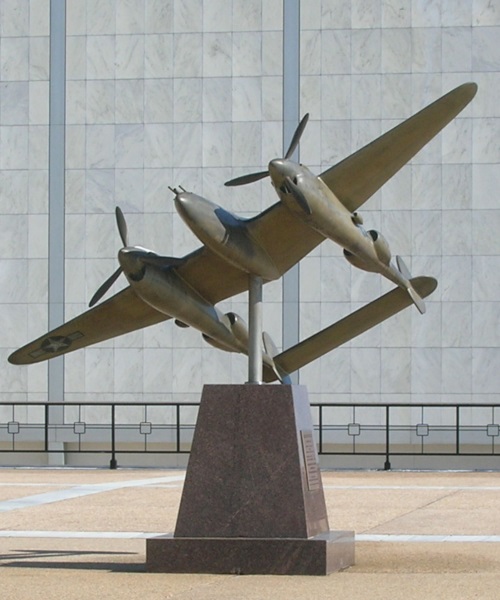
* One of the things that anybody who tinkers with aircraft history learns to be careful of is aircraft nicknames. The Germans supposedly nicknamed the P-38 the "Fork-Tailed Devil", and the nickname's even made it to the titles of books on the Lightning, but I eventually got suspicious, since it sounded like marketing or propaganda hype.
However, a German reader ran across this remark in an earlier revision of this document, and though he was only in his twenties he told me that he was once putting together a model of a P-38 and found that the model brought back unpleasant memories in his grandfather. The old man had been a young conscript at the very end of the war and had spent considerable effort dodging Lightnings shooting up everything that moved down the roads. He recalled that they were nicknamed "Gabelschwanzteufel", which translates pretty closely to "fork-tailed devil". That suggests they might have got the nickname from German troops instead of German pilots, since the P-38 made itself so insufferable as a strafer -- but that's a minor point.
* The story about GLACIER GIRL being found at 86 meters (250 feet) deep in the Greenland icecap was used by cranks to attack ice-core dating methods and the idea that the Earth is more than a few thousand years old -- claiming that the rate of ice buildup was so great as to throw estimates of thousands of years of buildup into the dumper. I found this a bit puzzling myself, but the answer turned out to be simple: the layers of ice become compressed and thinner as they are buried more deeply by later layers. Glaciologists are perfectly familiar with this phenomenon, and saw nothing particularly puzzling in the depth of GLACIER GIRL's burial. Sigh, it seems that no matter what I write about, I end up crossing paths with the fringe.
* Sources include:
The v1.3 version of this document also added information found in a detailed online document written by aviation enthusiast Joe Baugher.
* Revision history:
v1.0 / not dated v1.1 / 31 jan 97 / Extensions & tweaks. v1.2 / 01 jul 98 / Review & polish. v1.3 / 01 mar 01 / Rewrite & update. v1.0.4 / 01 jul 02 / Review & polish. v1.1.0 / 01 aug 03 / Added GLACIER GIRL comments, reorganized. v1.2.0 / 01 aug 05 / General cleanup and update. v1.2.1 / 01 jul 07 / Review & polish. v1.2.2 / 01 jun 09 / Review & polish. v2.0.0 / 01 sep 09 / Split into two chapters. v2.0.1 / 01 apr 10 / Review & polish. v2.0.2 / 01 mar 12 / Review & polish. v2.0.3 / 01 feb 14 / Review & polish. v2.0.4 / 01 jan 16 / Review & polish. v2.0.5 / 01 dec 17 / Review & polish. v2.0.6 / 01 mar 19 / Review & polish. v2.0.7 / 01 feb 21 / Review & polish. v2.0.2 / 01 feb 22 / Illustrations update. v2.0.3 / 01 jan 24 / Review & polish. (+)BACK_TO_TOP
